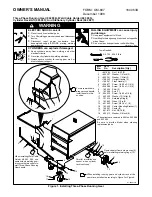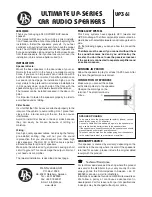
Speaker Systems for Background Music and Paging
page 3
Electro-Voice Installed Sound Technical Guide
To address such pitfalls, it makes good sense to have each proposal reviewed
by a second engineering employee whose approval should be required before
the specification goes to installation. At this stage, design details can be fine-
tuned and potential problems can be addressed to assure that the design is
feasible, efficient and free of unnecessary redundancy.
Selecting and Positioning Loudspeakers
In the traditional approach to overhead-distributed systems, loudspeakers are
located in a grid arrangement whose dimensions are dictated by the room
height and the directivity of the speaker elements. Two basic placement
patterns prevail: square spacing, and hexagonal (or crisscross) spacing.
In addition to the spacing pattern, the designer must choose between three
density types, designated respectively as edge-to-edge, minimum overlap and
center-to-center. The greater the overlap, the more uniform the coverage—
and the higher the cost. Budgetary constraints tend to favor sacrificing
density, so the optimum center-to-center configuration is, in practice, the
least common of the three.
Ceiling Speaker Size
System designers usually specify 8-inch cone loudspeakers for distributed
overhead systems, at least in part because they represent the traditional
choice. In many cases, however, you can achieve equal or better results—at a
significant savings—by using 4-inch elements. Characterized by somewhat
smoother frequency response and less susceptibility to feedback than 8-inch
elements, 4-inch units are also generally less expensive and offer a real
advantage in directivity.
Of course, a 4-inch unit will typically be somewhat less sensitive than a
comparable 8-inch. For equivalent motor assemblies, the difference is on the
order of 3 dB. The 4-inch will also have slightly reduced low-frequency
capabilities.
Expect The Unexpected
The distributed sound system market is highly competitive and margins are
small. It makes good sense to do everything you can to avoid problems at
the installation stage and to be ready to handle callbacks or last minute
changes smoothly. One way to do this is to anticipate problems before they
occur and build contingency plans into your operation.
For example, you should always have some inexpensive “fixes” at the ready.
Say that the customer decides to change his floor plan at the last minute,
©2002 Telex Communications, Inc.
Read more about
EV
®
ceiling speakers.
Ceiling speakers
data sheets:
205 Series 4”
405 Series 4”
EP405 Series 4”
EP407 Series 6.5”
PRO-8A Series 8”
209 Series 8”
309 Series 8”
409 Series 8”
EP 309 Series 8”






















